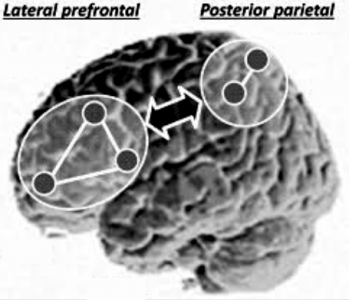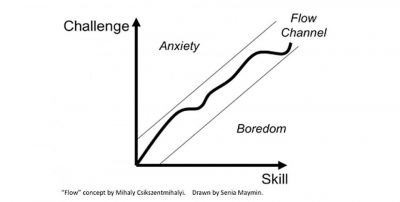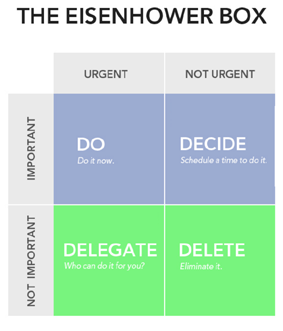Productivity Definition
Productivity is a measure of efficiency of a person completing a task – the efficiency of converting inputs into useful outputs. For example, the efficiency of the work and decisions you make to complete your daily ticklist. More technically productivity can be defined by dividing output (e.g. completing a project) by the total costs incurred or resources consumed (money, effort, psychological stress, etc) in a given period.

Note that productivity isn’t the same as just working hard – it is a measure of efficiency. Being more productive therefore benefits with how smart you are with the work you do: it’s not about quantity, it’s about quality and a work approach that is strategic.
Being productive is at the very heart of the popular 80:20 Pareto Principle:
“20% of your actions or inputs, products or services…will create 80% of what you want”
Tim Ferriss
Procrastination & Weakness of Will
A big hazard to productivity is failure of will and self-control where we act against our better judgement – for instance when we do either of the following:
- Procrastination: Putting off tasks with immediate cost but long-term benefit.
- Instant-gratification. The irrational pursuit of activities with immediate benefit but long-term cost.
For an in-depth blog article on procrastination visit this webpage.
The mindware strategies described below should help you deal with these productivity killers. The intention of this article is to encourage (a) more mindfulness and meta-awareness of whether you are being productive or not, and (b) more self-experimentation with your own productivity hacks.
Productivity Principles
Here are some productivity principles to consider for your Applied Intelligence Wheel productivity ratings.
Present Self and Future Self
Actively try to imagine, and identify more with, your Future Self – not just your Present Self that is the self that succumbs to procrastination. We often view our future selves as we’d view strangers, which is why we smoke, fail to save, and continue to eat cheap, convenient food rather than investing in a healthier diet and so on. It’s also why we procrastinate.
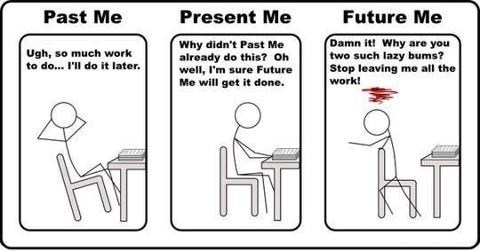
When you set goals for yourself like completing a 20 Session brain training program, or losing 10 kg of weight or increasing income by $1000— you are envisioning what you want your Future Self to have accomplished. Taking the time to vividly imagine the experience of your future self can help here.
Progress & Self-Efficacy
Teresa Amabile, a professor and director of research at Harvard Business School emphasizes making progress over productivity per se (ref). Progress is moving forward with one’s work; productivity is getting things done efficiently irrespective of their importance. Amabile found the sense of making meaningful progress has much greater positive impact on engagement and motivation than simply meeting deadlines or working through tick-lists.
Catalysts for Progress
Productivity research by Professor Amabile’s group has converged on the following catalysts for maximum productivity and progress (ref):
Clear, Challenging Goals
To be productive we need to know where our work is heading. Unambiguous short- and long-term goals give us tangible mileposts that make our progress salient and give us feedback on how we’re doing. And when the goals are set high and are personally challenging (not not too overwhelming and beyond the scope of our ability) they are more energizing and lead to greater effort. This underpins the popular notion of flow (or being ‘in the zone’). We thrive on a healthy challenge—something that stimulates us without being so difficult that it produces anxiety or so simple that it induces boredom. When you consciously and carefully choose a goal-focused task, you increase your chance of achieving flow.
Autonomy
We need to have a say in our own work – to have some ‘ownership’ of the decisions we make and the outcomes we are responsible for. When we have freedom in how to do our work, we can also be more creative. Much of our productive work now requires creative problem solving.
Resources
Access to necessary equipment, funding, etc, to make a project happen is a must – when we lack these catalysts, we realize that progress will be difficult or impossible, and motivation drops.
Help From Others
Getting the right sort of help, from the right people at the right time, can give a signi!cant boost to our motivation and productivity.
Learning from Failures
Our inner work life is more positive when failures and problems are faced squarely, analyzed, and met with plans to overcome or learn from them.
Goal Satisfaction: Successes
“If I have 10 things I want to finish in a day and I finish five, I get frustrated because I am not productive. If I have five tasks and I finish all of them, I feel productive, even if it’s the exact same five.”
Gregory J. Redington, president of Redcom
Continued motivation and engagement depend on a sense of ‘doing well’. When we meet or exceed our goals, we feel we are doing well; when we slip behind our targets, we feel we are doing poorly. In the short term, a shortfall may motivate us to try harder, but over the long term if we are consistently falling short it is demotivating and leads to disengagement, anxiety or depression. Energized, motivated people are more productive than depressed ones.
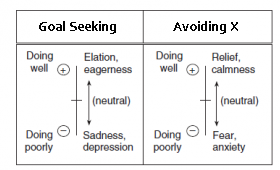
We also know from scientific research that optimal learning outcomes depend on success – on achievement of the learning goals you set yourself. Without success you do not get long-term hardwiring of the learning process in your brain.
So in terms of goal-setting, to increase productivity over the long-term, ensure that overall you experience net success, not net failure. In this way you can harness increasing motivation and positive emotion. Larger, more ambitious goals can be organized incrementally, in manageable steps that are challenging but attainable – all leading to the higher goal. And daily ‘tick lists’ can be reduced to ensure completion. Don’t be over-perfectionist, or over-striving if your goals and targets are unattainable. You need the reward that comes with hitting targets and making progress. Cut back on your targets, and build up a steady stream of successes to strengthen motivation, learning and productivity over the long-term.
Prioritizing
Prioritizing is a principle of productivity that is central to the ‘life-hacking’ work of Tim Ferriss, James Clear, and others of their ilk. Their view is that: productivity is getting important things done consistently. No matter what you are working on, there are only a few things that are truly important (ref). Prioritizing requires that we reflect on trade-offs at any given moment of conflicting demands, and make decisions accordingly – as illustrated in the popular Eisenhower Box.
When Franklin Covey recently surveyed 350,000 people worldwide, respondents confessed to spending 40 percent of their time on things that are unimportant or downright irrelevant.
“If you didn’t have any of that, and you could do one thing right now that would help get you to the next level of contribution, what would you do?” asks productivity guru and author Greg McKeown. “Maybe all the stuff you’re doing should be questioned. Start from zero every day. What would be essential?” People require space and clarity to identify what matters, McKeown explains, and what matters should dictate what (and who) you say yes to.
Habits
The other component besides prioritizing in the statement that productivity is getting important things done consistently is your ability to maintain a steady, average speed on certain things.
Our habits account for about 40% of our behaviors on any given day according to this Duke University review. Understanding how current habits work and how to build new ones efficiently is critical for making progress with your higher level goals.
Dilbert creator Scott Adams’s argues we need systems, not goals. ‘Systems’ are defined as ‘something you do on a regular basis that increases your odds of what you want in the long run’. A ‘system’ is a habit – and putting systems in place is strategic, much as laying a road or watercourse may be strategic.
Sticking to habits can also help with fostering a continuing sense of progress, positivity and motivation.
“If you do something every day, it’s a system. If you’re waiting to achieve it someday in the future, it’s a goal. […] Systems people succeed every time they apply their systems, in the sense that they did what they intended to do. The systems people are feeling good every time they apply their system. That’s a big difference in terms of maintaining your personal energy in the right direction.”
Scott Adams
One way of encouraging a habit is the Don’t Break The Chain hack that became famous with Lifehacker’s article ‘Jerry Seinfeld’s Productivity Secret’. This is the psychological trick of getting yourself to do something every day by looking at the chain of X’s for the days in a row you’ve done it so far. If you build up a nice streak it feels like a shame to break it – so you don’t. The Don’t Break the Chain technique is built into the better habit building apps on the market such as Productive for iOS or HabitBull for both iOS and Android.
Mindfulness
“Mindfulness is the basic human ability to be fully present, aware of where we are and what we’re doing, and not overly reactive or overwhelmed by what’s going on around us.”
Mindful.org
When you’re trying to get work done, it’s easy to lose focus and succumb to intrusive thoughts or instantly gratifying distractions. Productivity takes a hit. Also, ruminating on intrusive thoughts that build up their own momentum is associated with stress, chronic negativity and impulsivity which not only stifle productivity but also contribute to a slew of health problems.
If you are mindful of what you are thinking and feeling and what is going on around you, then you can manage the gap between your inner reactions a situation and your actions. Mindful people don’t ignore sources of restlessness and intrusive thoughts and feelings – that’s impossible. But they can acquire better ability to process it with more detachment and continually refocus attention on what is important.
Another advantage of mindfulness is that it concentrates attention on the qualitative, rather than quantitative, aspects of work–‘why am I doing this?’ instead of ‘how much of this am I doing?’ which helps with a sense of progress.
Mindfulness is also effective when it comes to the fallacy of sunk costs. The more time, thought, and energy you expend in pursuit of a goal, the harder it is to change course when the destination looks shaky. Research from the Wharton School shows that subjects who meditated were much more likely to abandon a lost-cause project than those who did not. Lost causes waste time and instill regret and regret kills productivity.
Practices to improve mindfulness for productivity can be found here.
Biased Views on Productivity
1. Strategic thinking is productive
Strategic thinking can result in the most advantageous long-term outcomes, but reframing situations, blue-skying for innovation and envisioning the future may not feel all that productive. It is abstract, open-ended and the outcome is uncertain. At the same time, more unimportant work, like clearing out your inbox, can leave you feeling more satisfied in your productivity.
To help with this irrationality, try thinking in terms of your future self -where you will be over the long-term not just the next few days or weeks. Short term gains may be over-weighted in your subjective calculus; long-term rewards may be undervalued. Try using the double loop learning model, and set aside time periodically to think strategically by doing some reflection on your assumptions, frameworks and overall goals.
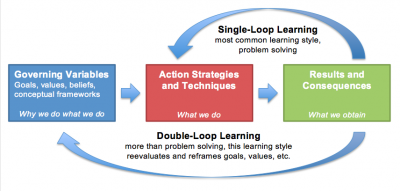
Embody your strategic thinking in strategic plans, and then commit to strategic actions. Plans are concrete outcomes, and commitments are actions and both may provide a more compelling sense of productivity.
2. Rest breaks increase productivity
It is easy to fall into the trap of overdoing it – working with faulty assumption that there is a straight line going up: more hours equals more productivity. Facebook, Cisco, Apple… places where the reigning assumption may be if you’re not working 70 hours a week then you’re a slacker. To make matter worse, the restful activities you know are good for you may at some level be seen as self-indulgent when compared with work – particularly if you feel under pressure to make progress.
But there’s more than a century’s worth of research that overwork in the long run is bad for our wellbeing and also bad for productivity. Insufficient sleep and leisure affects performance negatively. You get more done quicker when you step back and recharge the brain and body on a regular – daily – basis. Based on this research, progressive companies like Basecamp and Treehouse have been limiting email contact in the evening and reducing the length of the working day.
Active rest. Note also that many of the most restorative kinds of rest are actually active. Moderate exercise, walks or serious, engaging hobbies such as cycling can do much more for your overall well-being and productivity than sitting on the couch binge.
Brain Training for Productivity
Gated dual n-back training can help improve brain network efficiency in brain regions underlying flexible goal-pursuit and problem solving – which can improve cognitive productivity. The scientific evidence shows gains from longer term working memory brain training (e.g. 10 hours) in the following ways:
- Neurotransmitter efficiency – e.g. changes in dopaminergic receptor density and dopamine release at synapses (ref, ref).
- Improved dynamic network ‘tuning’ of signalling in neural networks. (ref, ref).
- Changed network organization in the frontoparietal network resulting in more optimal information transfer (ref). The frontoparietal network is a ‘hub’ network in the brain, due to its brain-wide functional connectivity patterns. This flexible hub connectivity throughout the brain is the basis of higher level executive processing and attention control, and helps with any kind of novel, adaptive task or goal pursuit (ref), as well as task focus in the face of distractions and temptation for instant gratification. Gated dual n-back training directly targets the frontoparietal network, increasing connectivity within this network (ref).
